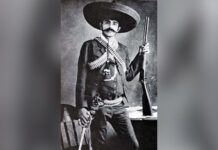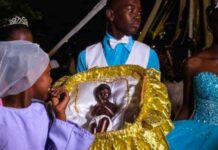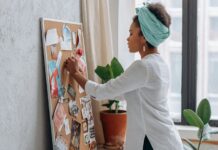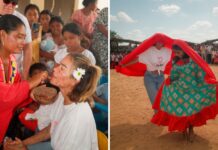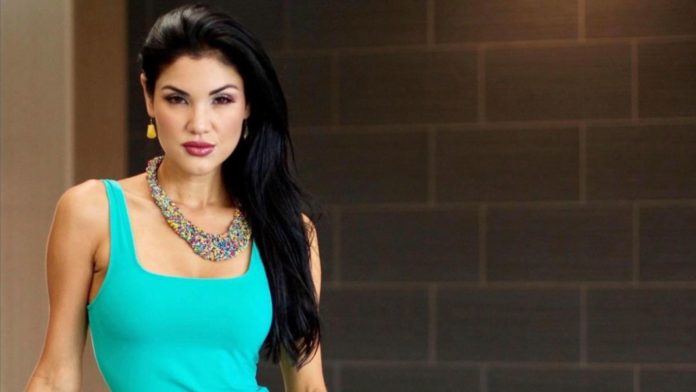Yasin Cuevas often tells “her girls” —as she refers to the Latina high schoolers enrolled in her Miss Latina Image Leadership Program— that discipline is a key part of leadership.
It is a value she lives by her example. The model, leader, coach, and educator is the founder and director of the Miss Latina Image Leadership Program, a six-month modeling and leadership afterschool program for Latina teens at Julia de Burgos Cultural Arts Center in Cleveland, OH. The program she champions is a passion project she devotes herself to alongside her full-time job as assistant director of programs at Esperanza, Inc., a Hispanic education nonprofit, and her ongoing work as a model and coaching as CEO of Project Model Institute.
For Cuevas, it is all interconnected because it is work that expresses her values, many of which are rooted in what she describes as a “humble” upbringing with a loving family in Utuado, Puerto Rico.
We sat down with Yasin to learn more about her model journey, the modeling industry’s good and bad, the importance of women’s empowerment, and more.
This interview has been edited and condensed for brevity.
Can you tell me a little bit about yourself and your story?
I come from a humble family in Utuado, Puerto Rico. I’m really proud to be from Utuado because that town is family-oriented in the mountains, and I grew up with a lot of nature and a close neighborhood.
And then, when I was maybe 11 or 12, some people reached out to my mom and said, “You should put your daughter in modeling classes.” It was an academy that prepared girls for that field in the town next to mine, and my mom traveled there with me on public transportation.
My father, my mom, my brothers, and my family made a lot of sacrifices for me to be in these classes because they’re not cheap. Many girls at that age want to join so many things, but if you come from a tight family, it’s so much you can do.
I didn’t understand then, but now I can look back and say, oh my god, I cannot imagine how many sacrifices my family made for me to go every Saturday and take these classes.
I won my first graduation among a lot of girls, and then my father saw that I had good discipline in it, and they went on and paid for the second year of classes. At age 15, I was already teaching other girls. I was a teen teaching teens and adults. Teaching and giving to other women was something that I started learning really early at that age.
I grew up like that. Modeling was my career until university. That was my job until I was maybe 27. And I retired, and when I retired, I moved to the United States to learn English, and here I realized there was not a lot of opportunity for Latinas in that field. There were other communities in the modeling field, but not Latinas. And I was like, “I should do something.”
And I realized that the girls need that mentor or someone who teaches them that you can do everything in life. You can do it all, but you have to understand some boundaries of when you’re going to do it and who you’re going to do it with.
I came up with the idea of classes for girls in my community for free. I made an appointment with Julia de Burgos Cultural Arts Center to volunteer to run a program for free for young girls. And they accepted me, and I got my curriculum and all my ideas.
I started working with the queen of the Puerto Rican parade, choosing that girl. But it was more like a pageant. And I wanted more than that. I wanted girls to support each other. I didn’t want the competition vibe. Then thank god, I got an amazing director there, called Letitia Lopez. She helped me to develop this new program called Latina Image. We changed it from only the Puerto Rican community to all Latinas.
It looks like a pageant at the end of the program, but you earn all those points through the entire program of six months. Then you walk in. You’re going to represent a value of a leader. The sashes will say, “Miss Confidence,” “Miss Leadership,” “Miss Friendship,” and “Miss Empathy.” During this program, they must research and learn from the value they represent. And they sometimes realize, ‘Oh my god, my value is important, but without your value, we wouldn’t be here.’
They start learning from their value, and through that process, I do teach them modeling. If I don’t put the modeling there, they will not join! That is my entire hook to this program. I don’t take that away because the girls love it.
We try our best to make it fun for them. We do photo shoots and modeling classes and teach many soft skills. Sisterhood, how can we embrace women among us? If you look good, we’re all going to look good. And then they start doing, okay, yeah, we’re sisters.
We teach the proper way to prepare for an interview, what to wear, what not to wear, what is the correct makeup, and what not to do. I teach them table etiquette and cellphone etiquette. Public speaking. They speak about their value in front of all their families, and for some of them, it’s the first time with a mic in their hands.
We try to give them different experiences, and before the experience, I teach them some etiquette they will use in those places. Then they know what to expect.
It’s a six-month program, and the two girls with the highest points get crowned. And they represent Julia de Burgos and the Latino youth community in our area.
Many of those skills are relevant to modeling but so important in any profession.
Yes. We teach them how to do a proper interview, and they actually have an interview. They come prepared and dressed. I tell the girls, I know that you love those nails, but for interviews, you need to use neutral colors. Length is important. Your makeup has to be natural.
I try for them not to lose who they are. I tell them, I’m going to give you all this information, and you twist it to your own. You make it your own. Because I don’t want you to lose your personality in the process. I want you to grow.
And if a girl doesn’t want to wear a dress when we have the final gown presentation, I tell them, you can wear a tuxedo, but it has to be formal. I’m okay with everything, but we need to understand what the occasion is.
The options are there for them to embrace who they are and learn that there is a correct way to do things. There is a moment and place for everything.
And as Latinas, we must represent everywhere we go. Because I tell the girls, even if you want it or not, you represent all of us. Whenever I go to a place where maybe I am the only Latina, I automatically know that I have to do even better because I represent all of us at that moment.
For the girls that you work with, how do you talk to them about that kind of pressure?
I tell them it’s real. And it’s something that, again, I get it, we’re part of this melting of all these diversities, but this is my point of view, we do have to represent everywhere we go. We must be careful of how we embrace ourselves, but you can tell I’m Latina, and I don’t want to have the perfect accent. I’m not expecting to be an American completely. I want to bring something to the table. The United States is giving to me, but I can give back too.
I’m coming here to add, not to take only and put a bad image into who we are. We need to add to it in a positive way. I tell the girls that everywhere we go, we need to be more conscious about it because it’s the reality that we’re living.
What is your job with Esperanza?
I’m the assistant director of programs for Esperanza, a Latino organization promoting high school graduation and post-secondary education. We want our Latinos to graduate, keep going to college, and support them. And even if they’re not college material yet or want to do something different, we want them to have a plan. Then I am really connected with my community and our Latino students, and I volunteer with this program in Julia de Burgos. I have a team of people that work with me in the program. I’m the director, but I think we’re six, and we’re all volunteers.
And we do this from our heart, with the desire to do better, to give something. I love it. I enjoy it a lot. In the photo shoot, you can see girls that were maybe self-conscious, and they see themselves in that photo, and everything changes for them. They just feel pretty. They feel, and I get it, it’s a little bit of makeup, the lights, and the photo, but it does change the perspective. They’re like, ‘Oh my god, that’s me!’ Yes, that’s you. And some girls love that transition because they see themselves in a different way, and you see their faces shine when they see it. At that moment, you know the self-esteem of that girl changed. It just changed, and we try to have that in every class.
Sometimes I don’t recognize them at the end.
What are the things you like best about modeling, and what are things that you wanted to change in the industry or still would like to see change that isn’t perfect?
If we continue moving in this direction of diversity, and inclusion, women of all sizes, all shapes, and all colors, I think it’s important. We’re still fighting with the unrealistic image people sometimes put out there, especially on Instagram. There are beautiful people out there, but realistically, a lot of people will put something together just for you to have that thought. And in the modeling industry, I think we’re moving in the right direction, but it could be faster. This should have happened long ago, but I’m glad it’s happening now. Because before, working in a place and seeing a plus-sized model in a bikini was something that I never thought I would see, and I’m so glad that I’m now seeing it.
Now, sometimes I still think I see some marketing of plus-sized models, and I’m like, she’s not plus-sized!
Maybe I have big hips, and I would be considered plus for something, and I’m like, no. I don’t think I’m a plus. But I think there’s some work that we still need to do, but I have seen some change and am glad. The same with pageantry. Now I see more girls in a wheelchair or bigger girls, and I’m like, “Yes, girl, break those rules.” Because we don’t need that.
I have plus girls who tell me they didn’t join [Latina Image] because they “thought it was for the skinny ones.” And I’m like, no, my program is for everyone. And I remember I encouraged one girl, I was like, you need to do this for all the girls out there, that they don’t want to join because they think the same that you thought. And I’m telling you, I will help you if you do this for me. Because I cannot be somebody from the inside saying it, they need to see a girl just like you. And I remember her joining my program, and after her, I had more and more girls in the plus-size. And I don’t call them plus-size. You’re just a person like anybody else. But when I see them coming in and sign, I’m like, “Yes.” Because health is important too, and maybe there is a healthy part that we need to talk about, but I don’t want them to not join the program because of how they look.
I’m glad my program has opened that door, but I want more girls to understand that this is for everyone. It’s not about how you look. It’s about what you do. And that’s what I really want, and I would like to see a change in modeling.
What type of projects are you most interested in doing now in terms of your modeling work?
I like modeling all over. I can do a little bit of everything. I can do commercials. I can do entertainment. I’m really open to a lot of things, but something they ask me if it’s a little too much, I’m like, no, I work with young girls, and I have to be careful what I do. I’m just a little more careful with the outfits. What is the deal with the photo before I take the job? Because I don’t want to be disrespectful of anybody’s art. When you sign for something, you are the model. You have to manage for them to see whatever they want to see or the image of the project you want to make it alive. So I always ask those questions to know whether I can do it.
For Image credit or remove please email for immediate removal - info@belatina.com















